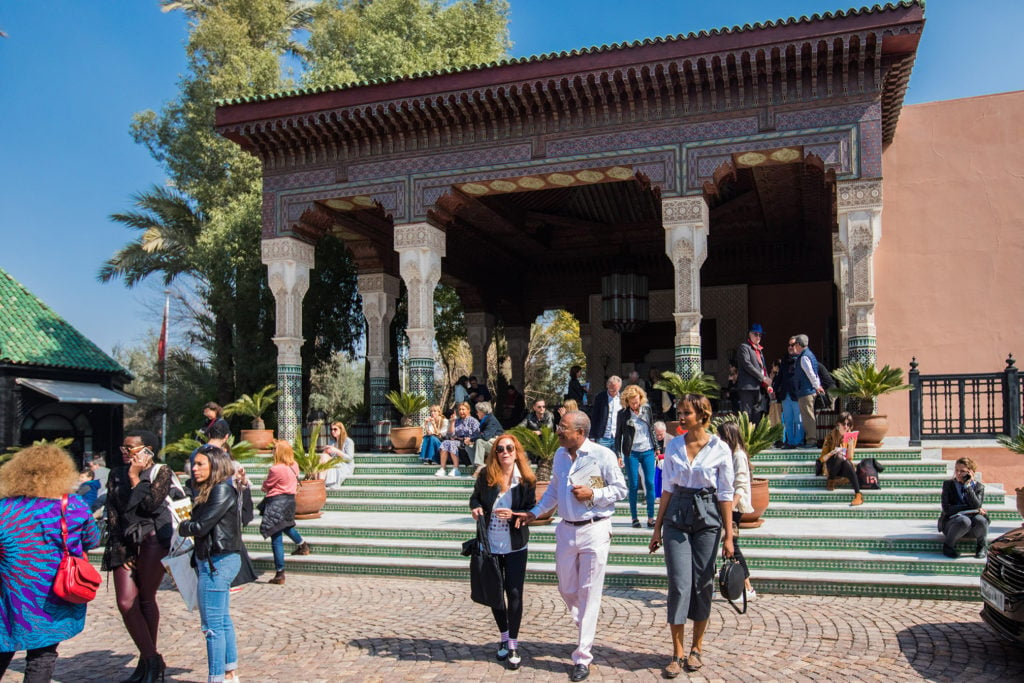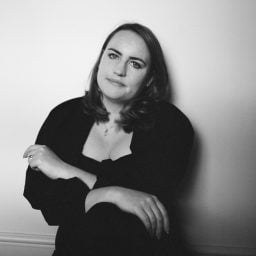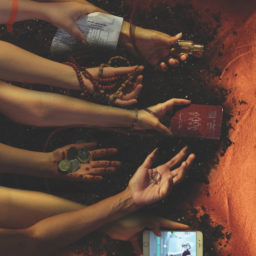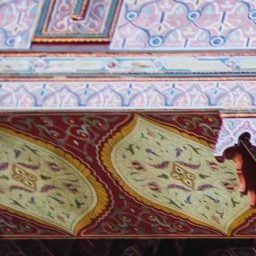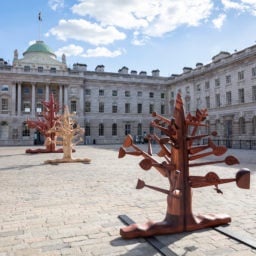Few cities capture the popular imagination as Marrakesh. Some two million tourists were drawn to the dusty, pink-hued ancient city in 2017 to ride camels, gawk at belly dancers, and eat couscous. Visitors can visit hammams (bath houses), the Saadian tombs, or get lost hunting for bargains inside the labyrinthine souks within the walls of the old medina.
But the region—and the entire continent—are undergoing rapid development. The global consulting firm McKinsey & Company predicts that Africa’s combined GDP will reach $2.6 trillion by 2020, with 128 million households contributing to a total of $1.4 trillion in consumer spending.
Morocco is among the countries attracting attention, including from those in the arts. A new contemporary art museum opened last year, and at the triennial Africities summit at the end of 2018, Marrakesh was named the 2020 African Capital of Culture.
Suddenly, the city seems to have officially made it onto the art world map. The French auction house Artcurial realized this early on, holding its first sale in Marrakesh in 2015. Last December, it brought in €839,900 with its third sale in the country. Buoyed by pockets of cultural activity, including the arrival of the 1-54 Contemporary African Art Fair last year, globetrotting art collectors are getting their feet wet as the city moves to become an art market hub, nicely situated between Europe, Africa, and the Middle East.
The arrival of an art fair with a solid reputation built in the art world centers of London and New York is a boon. But until now, Marrakesh hasn’t been known as an ideal place to trade in art, particularly because its national currency, the Morrocan dirham, is not exchangeable internationally.
There are challenges facing the city, including a dearth of funding for the arts. A much vaunted photography museum designed by star architect David Chipperfield, slated to open in 2016, has yet to materialize. The seventh Marrakesh Biennial, due to open in February 2018, was postponed due to financial troubles, and is now dead in the water. What’s more, with competing demands for investment in education and healthcare, public support for the arts seems to be hard to find. So is the momentum generated by 1-54 enough to sustain a legitimate scene?
How to Make a City a Fair Destination
Marrakesh has a natural allure, and has been drawing artists for decades. French painter Jacques Majorelle arrived in the early 1920s and never left. Brice Marden has lived and worked out of the city at various points since 2015. (He had his first show in Africa during the fair at the nearby Yves Saint Laurent Museum.) Winston Churchill used to paint from his balcony at the glamorous Mamounia hotel, which hosted the fair. Local artists include Hassan Hajjaj, known as “the Moroccan Andy Warhol” because of his Pop-esque riffs on the wares offered in the souks.
But that doesn’t mean the arrival of 1-54 to Morocco was inevitable. The seemingly tireless director of the fair, Touria El Glaoui, tells artnet News that the expansion into Africa could have taken 1-54 to a number of cities. Lagos, with its booming economy and local energy for the arts, was one option. Cape Town, home to the shiny new Zeitz MOCAA museum, was also on the table.
But it was important to El Glaoui that the city be easily accessible, a need Marrakesh serves easily. It is a short flight from most of Europe; has no visa or vaccination requirements; and is relatively stable politically, putting it at an advantage relative to other cities across the continent.
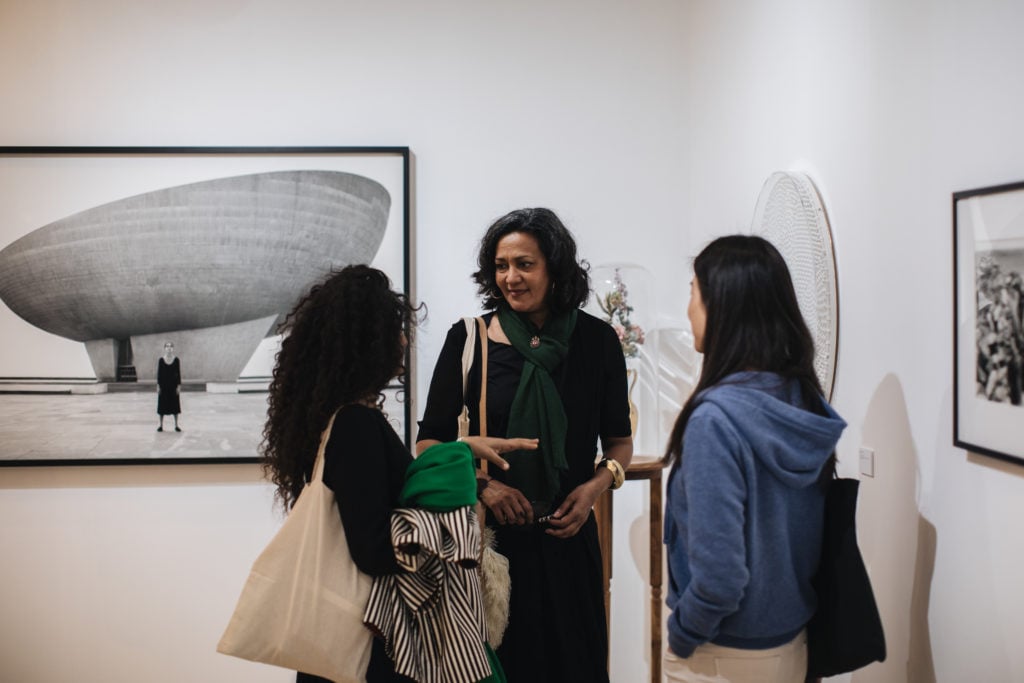
The Goodman Gallery booth at 1-54 Marrakesh 2019. Photo © Katrina Sorrentino.
There was another draw for El Glaoui: Marrakesh is her hometown. She’s familiar with its various administrative hurdles and knows how to liaise with customs authorities. A representative for the Goodman Gallery, which is based in South Africa, said the gallery was impressed that their shipments to the city, which included impressive works by Shirin Neshat, arrived on time—which is not necessarily something that can be said for all international fairs.
Through her connections, El Glaoui was also able to address a potential currency exchange nightmare. Curiously, the Moroccan dirham is a closed currency, meaning that it cannot be exchanged outside the country. That poses a problem for international exhibitors, who would have no use for dirhams after they left Morocco. El Glaoui’s friendliness with the Office des Changes, the city’s exchange bureau, was essential: she was able to arrange special convertible accounts for collectors, allowing them to buy in any currency.
A Lot to See—but Less Than Expected
Her efforts have largely paid off. This year’s edition of the fair, which closed Sunday and included some 65 artists from 18 international galleries and welcomed 6,000 visitors, drew the necessary collector base.
“For me, what really makes Marrakesh such a great edition of the fair is its fantastic offsite programs,” said Lebanese-born British construction magnate and collector Marwan Zakhem, who owns Gallery 1957 in Accra, citing the “exhibition openings, studio visits, museum tours, dinners, and parties hosted by locals that give a dynamic overview of Morocco’s truly vibrant culture.”
Unlike the editions in London and New York, the Marrakesh fair had a rich program that gave the event a biennial feel. DaDa, an edgy art space just off the famous Jemaa El Fna square, is still under construction, but it was opened temporarily present installations by Emeka Ogboh, Mohamed El Baz, and Mo Balaa. Elsewhere, in the city’s Guéliz neighborhood, an evening was dedicated to dealers from the city’s growing commercial scene, with shows by solid galleries including David Bloch, Comptoir des Mines, and Gallery 127.
But the cancellation of a major concurrent event, the Marrakesh Biennial, gave the organizers of 1-54 less leverage with which to draw collectors.
Vanessa Branson, who founded the biennial in 2004 and sponsored its operations for years, told artnet News the show will not be making a return in 2020.
“Nothing’s forever,” she said. And while Branson hopes the biennial will be resurrected, “the key is going to be that the next generation steps up.” Although the show was backed by local organizations, she said they mostly gave in-kind support, such as the use of space, which doesn’t pay for labor. So far, no one has filled that necessary sponsorship gap.
“It’s difficult to communicate how important the arts are as an economic driver,” Branson said.
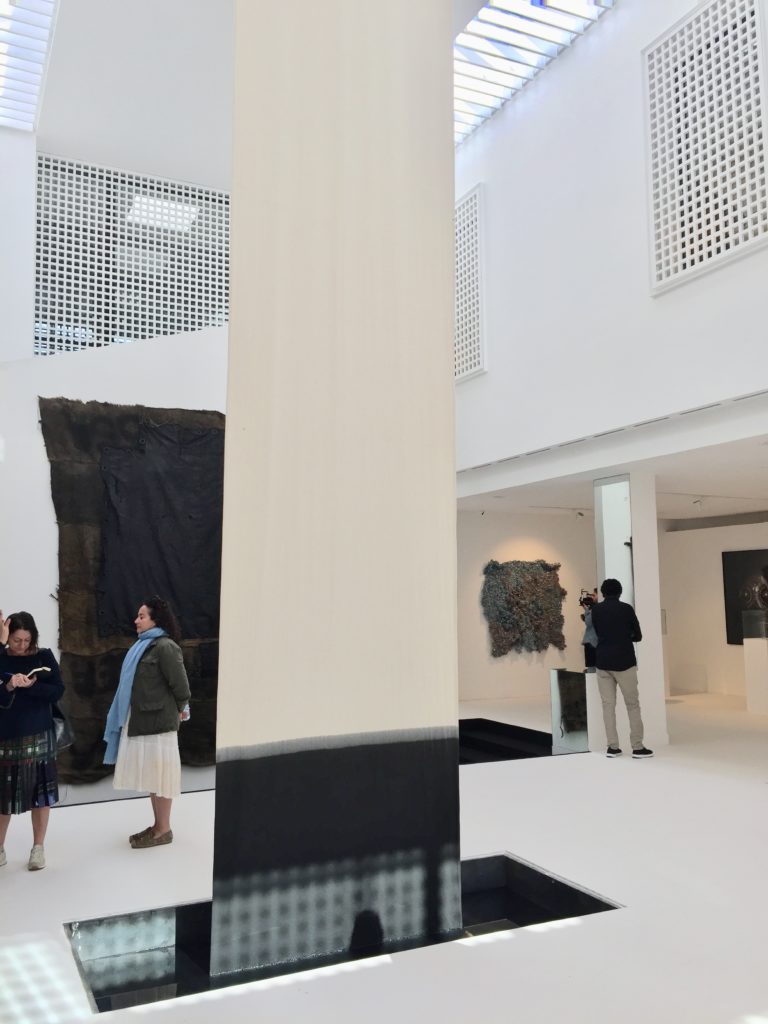
Alexandra Karakashian, Black Sea (2019) at the 1-54 Contemporary African Art Fair. Photo by Naomi Rea.
For the first two editions of 1-54 in London, the Moroccan ministry of culture subsidized a few Moroccan galleries, covering half the costs of their stands. And King Mohammed VI—himself an art collector—opened the Mohammed VI Museum of Modern and Contemporary Art in Rabat in 2014. But for the most part, state support of the arts has been deprioritized in a country where investment in education and health services are urgent necessities.
So private money fills the void. In 2018, the Lazarq family, which made its money in real estate, opened MACAAL, the African contemporary art museum, to showcase its collection. The family also runs the the Al Maaden sculpture park on a golf course surrounded by the Atlas mountains.
Standing by a striking installation made from engine oil and linen by the South African artist Alexandra Karakashian, MACAAL’s president, Othman Lazraq, said that art is not yet a priority for many Moroccans. “I really do think culture is an [indication] of development for a country and it is a shame this is not recognized,” he said.
But similar spaces to MACAAL might spring up if tax breaks are offered as an incentive, he said. In the meantime, Lazraq says organizations like his are happy to take charge. “We’re proud to lead the way,” he said. “But we need five or ten MACAALs.”
